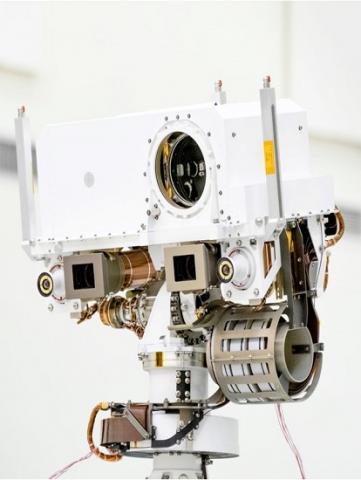

The Mars2020 Mission Takes Off: In search of signs of life on Mars
Mars2020, NASA's next Martian mission will be launched at the end of July 2020.
The mission’s goal is to deposit the Perseverance rover on the surface of the red planet, which will then study if the conditions of Mars are habitable and search for signs of past life on Mars. The Perseverance rover will collect samples and pack them so that they can be brought back to Earth in future missions. NASA is relying on Caltech/JPL for the development of this rover. At the top of its mast are the optical and electronic elements of the five instruments that make up SuperCam, intended to study the chemistry and mineralogy of the rocks and soils of Mars, as well as the composition of its atmosphere. Many laboratories associated with Sorbonne University have contributed to the creation of the SuperCam instrument: the Laboratory of Space Studies and Instrumentation in Astrophysics (LESIA), the Atmospheres, Milieux, Spatial Observations Laboratory (LATMOS) as well as the Institute of Mineralogy, Material Physics and Cosmochemistry (IMPMC).
SuperCam will study the chemistry and mineralogy of the rocks and soils of Mars, as well as the composition of its atmosphere. This highly innovative ensemble of instruments was jointly developed by LANL (Los Alamos, USA) and a consortium of French laboratories led by the Institute for Research in Astrophysics and Planetology (IRAP, Toulouse, France), with a contribution from the University of Valladolid (Valladolid, Spain). The CNES is responsible, vis-à-vis NASA, for the French contribution to SuperCam. The CNES, CNRS and many universities including Sorbonne University have provided their expertise. The French team contributing to SuperCam will participate in daily scientific operations and the instrument will be operated alternately from the LANL and the control center installed at CNES in Toulouse (FOCSE March 2020). Many of the laboratories that contributed to the creation of the SuperCam instrument are associated with Sorbonne Universityz: the Laboratory of Space Studies and Instrumentation in Astrophysics(LESIA), the Atmospheres, Milieux, Spatial Observations Laboratory (LATMOS) as well as the Institute of Mineralogy, Material Physics and Cosmochemistry (IMPMC).
Four CNRS researchers at the IMPMC lab (Sorbonne University/MNHN/CNRS) provided expertise in the development of the SuperCam instrument, particularly for the Raman spectroscopy, and have since been heavily involved in the manufacturing of calibration targets. For the latter, the lab contributed to the target definition and provided reference minerals from the Mineralogy collections of the MNHN and Sorbonne University. With the help of the IMPMC's project unit and the collaboration of physicist researchers, the IMPMC also quickly set up a unique and original experimental bench for Raman spectroscopy and luminescence similar to the SuperCam instrument and including the remote analysis in Martian chamber. This instrument was in great demand for the calibration of SuperCam and to initiate scientific studies in accordance with the themes of the mission, in particular by using certain samples from the Sorbonne University mineral collection.

Vue d'artiste du rover Perseverance et présentation des instruments scientifiques
From a scientific standpoint, the IMPMC researchers will first be involved in the day-to-day management operations of the SuperCam instrument by analyzing the data received and helping to shape the rover's future operations. Their expertise lies at the geological level, whether on issues concerning the mineralogical and geochemical composition of rocks, and more generally the global geodynamic evolution of the planet Mars or the weathering processes on its surface under the water circulation effect for example. These researchers also have recognized expertise for the flagship theme of the mission, which concerns astrobiology and the search for signs of current and past life on the surface of Mars. They will therefore be particularly involved in the selection of sites for sampling to be brought back to Earth as part of the global project to return Martian samples to try to finally answer the fascinating question of the possible existence of life on Mars. After a journey of several months, the Perserverance rover will land on the surface of Mars on February 18, 2021.

Instrument SuperCam situé en haut du mât (l'«œil) » du rover

Dispositif de spectroscopie Raman résolu en temps de l'IMPMC, permettant de faire des expériences en chambre martienne (à droite de l'image) grâce à l'analyse à distance avec un téléscope (en haut à gauche) ©IMPMC
Researcher contact: Olivier Beyssac, research director at the Institute of Mineralogy, Material Physics and Cosmochemistry (IMPMC)
